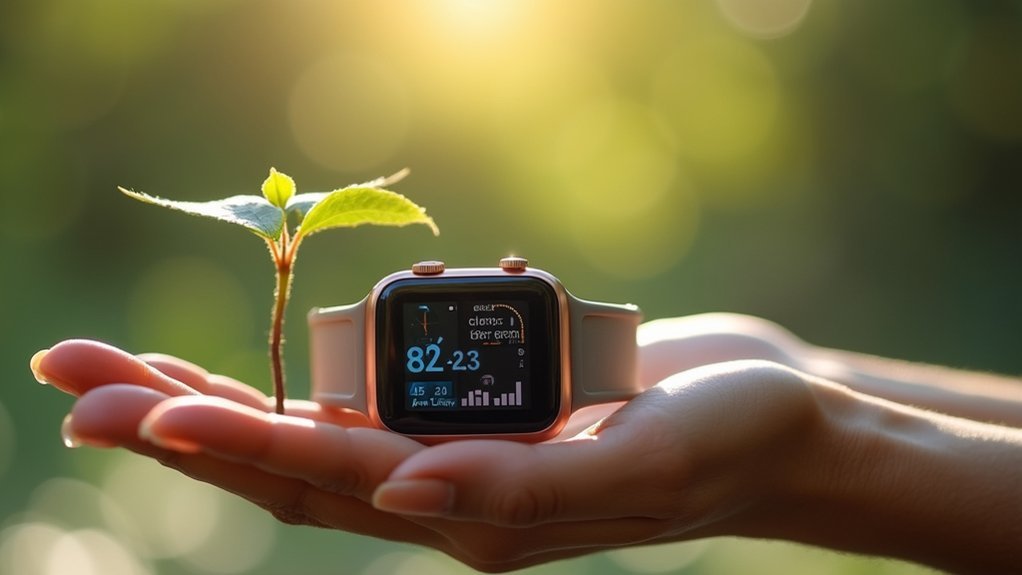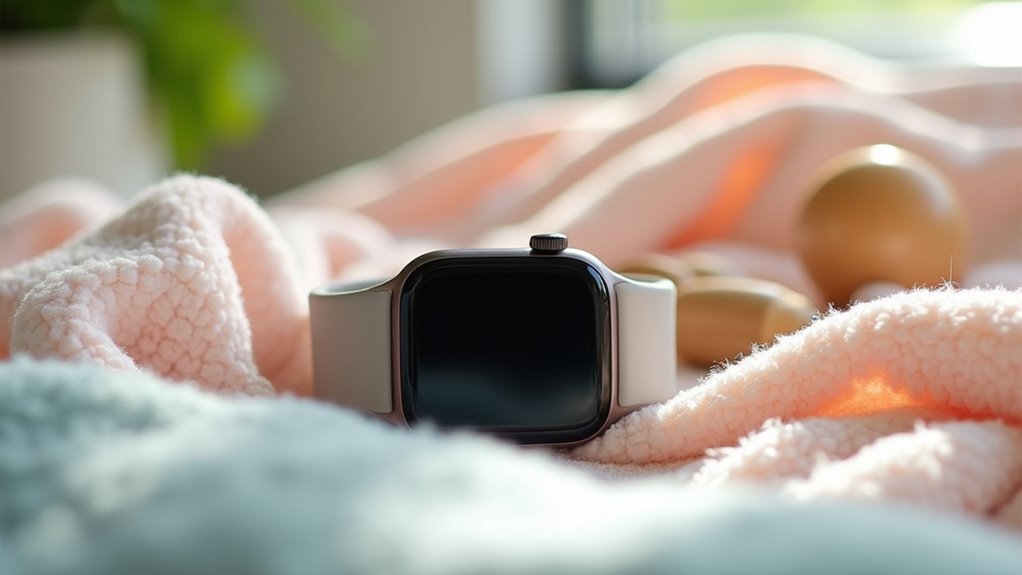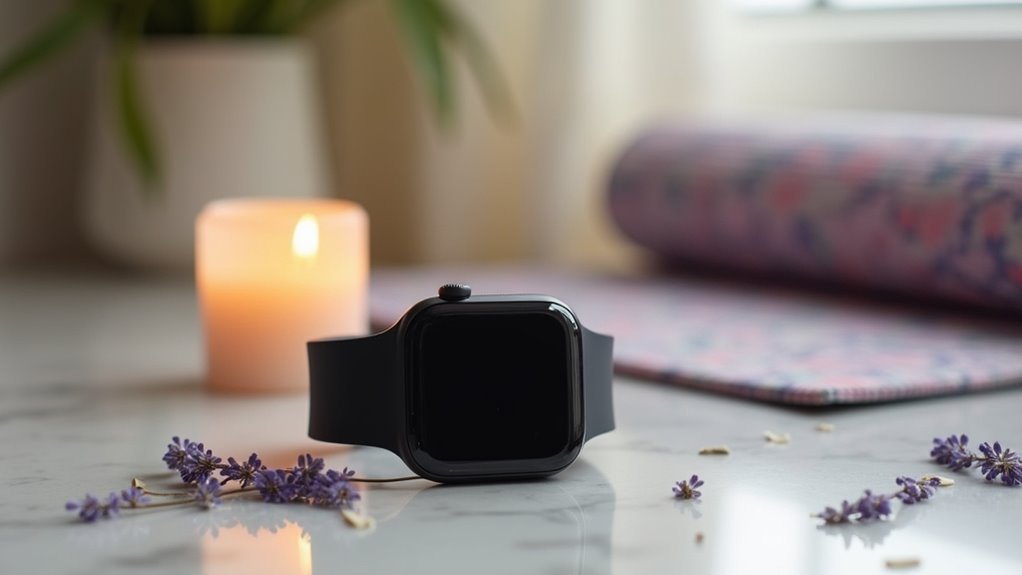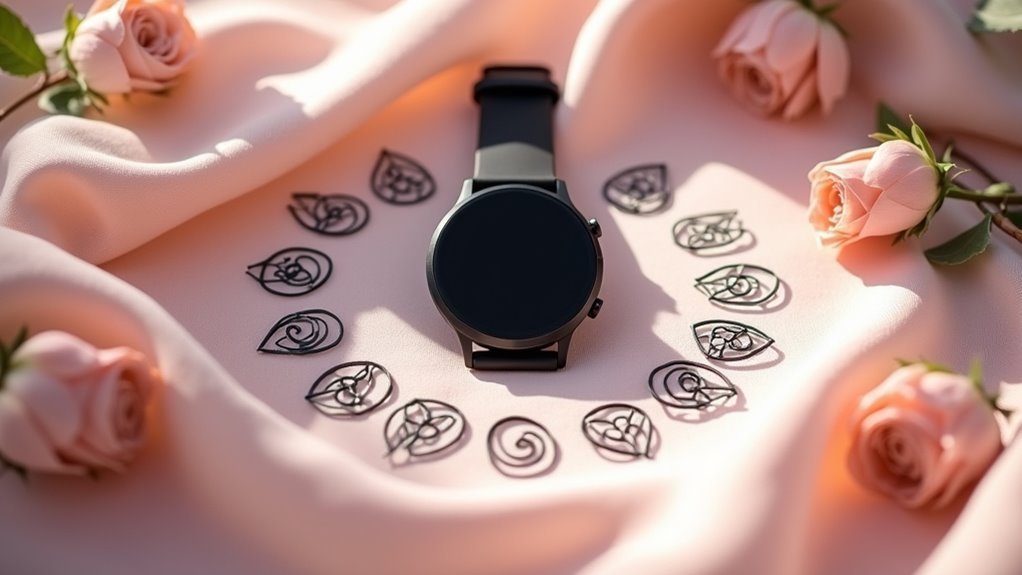EDA stress tracking smartwatches show mixed effectiveness depending on your device choice and usage conditions. Medical-grade options like the Empatica E4 achieve 99% accuracy, while consumer models like Fitbit Sense offer decent but less reliable results. You’ll face challenges from movement artifacts, environmental factors, and individual stress response variations that can impact readings. When combined with heart rate variability monitoring, these devices provide better insights into your stress patterns and recovery, though real-world accuracy varies considerably from controlled testing conditions.
How EDA Technology Works in Modern Smartwatches
When you check your stress levels on a modern smartwatch, the device measures electrodermal activity (EDA) by injecting a tiny, low-frequency alternating current between two electrodes that contact your skin.
Modern smartwatches detect stress by sending small electrical currents through skin-contact electrodes to measure electrodermal activity changes.
The system then measures voltage across these electrodes, providing real-time indication of your skin’s conductance changes. This works because your sympathetic nervous system triggers sweat gland activity when you’re stressed or emotional.
Increased sweat secretion lowers your skin’s impedance, increasing conductance that the watch detects instantly. The low-frequency AC current—typically operating at tens of Hz—flows mainly through your skin’s superficial layers, focusing on physiological rather than environmental effects.
Advanced circuitry compensates for the high contact impedance from small wearable electrodes, ensuring accurate signal detection. Research at the University of Houston has developed closed-loop technology that can trigger stress management reminders when elevated stress levels are detected through skin conductance response.
Comparing EDA Accuracy Across Different Smartwatch Brands
While all EDA-enabled smartwatches measure your skin’s conductance changes, their accuracy varies dramatically depending on sensor technology, electrode placement, and data processing algorithms.
| Device | EDA Method | Accuracy Level |
|---|---|---|
| Fitbit Sense | Fingertip scans | Consumer-grade |
| Empatica E4 | Continuous wrist | Medical-grade (99%) |
| Shimmer GSR3+ | Research sensors | Clinical-grade |
| Apple Watch | No native EDA | Not applicable |
| Generic brands | Limited/none | Variable |
You’ll find Empatica E4 delivers the highest precision with continuous 4Hz sampling, making it research-preferred. Fitbit Sense offers user-friendly stress scores but sacrifices accuracy for convenience through on-demand scanning. Most consumer devices can’t match medical-grade precision, though recent studies show wrist-based EDA achieving 96-99% accuracy in controlled conditions. Your choice depends on whether you prioritize clinical accuracy or everyday usability.
Research conducted during the COVID-19 pandemic with twelve participants aged 18-26 years revealed significant differences in correlation patterns between consumer and research-grade devices when compared to laboratory equipment.
Benefits of Combining EDA With Heart Rate Variability Monitoring
Although EDA captures your immediate stress responses through skin conductance changes, it tells only half the story of your body’s stress management system.
When you combine EDA with heart rate variability monitoring, you’ll get thorough insights into both your sympathetic and parasympathetic nervous system activity. This dual approach enhances your stress assessment accuracy considerably.
HRV measures your parasympathetic activity, which regulates stress recovery, while EDA tracks sympathetic responses during acute stress. Together, they provide real-time feedback on your autonomic nervous system’s balance.
Devices like the Empatica E4 wristband integrate both metrics, offering continuous, non-invasive monitoring. You’ll benefit from early detection of stress-related health issues and more precise stress state differentiation than either measurement alone could provide. Research shows that dyadic conversation can influence respiratory changes that directly affect HRV measurements, highlighting the importance of contextual monitoring.
Real-World Performance and User Experience Insights
You’ll find that your EDA smartwatch’s stress detection accuracy fluctuates throughout the day due to movement artifacts, environmental changes, and varying activity levels that can trigger false readings.
The device’s comfort becomes essential since you need consistent skin contact for reliable measurements, but bulky sensors or poor strap design can cause irritation during extended wear.
Your real-world experience will largely depend on how well the smartwatch balances accurate sensor placement with lightweight, breathable materials that you can comfortably wear 24/7. Studies show that prediction accuracies for perceived stress range widely from 42% to 100%, with an average of 82.6% across different wearable devices.
Daily Accuracy Variations
The accuracy of EDA stress tracking in smartwatches fluctuates greatly throughout your day, with performance varying based on your activities, environment, and physiological state.
Environmental factors can appreciably affect EDA signal quality, reducing stress detection accuracy when you’re in challenging conditions. Your individual stress responses create additional variability, as universal algorithms struggle to account for personal differences in how you react to stressors.
Your daily activities and routines directly influence stress level readings, making some measurements more reliable than others. Continuous monitoring through wearable integration into daily life provides ongoing physiological data collection throughout various situations.
Machine learning algorithms like SVM can achieve 92.9% accuracy under ideal conditions, but real-world performance often falls short of laboratory results. Data quality and consistency become vital factors, as poor signal collection during certain activities can compromise your smartwatch’s ability to accurately detect and track stress levels.
Comfort and Wearability
Beyond measurement precision, your smartwatch’s physical design and comfort level greatly impact how effectively it can monitor your stress throughout the day.
When your device feels bulky or causes skin irritation, you’re less likely to wear it consistently, which compromises continuous stress tracking capabilities.
Key factors that determine your smartwatch’s real-world effectiveness:
- Breathable materials and water-permeable electrodes prevent sweat accumulation during workouts and daily activities.
- Lightweight design with adjustable straps guarantees secure fit without causing discomfort during prolonged wear.
- Intuitive interface with real-time feedback keeps you engaged and helps you understand your stress patterns immediately.
- Long battery life maintains uninterrupted monitoring without frequent charging disruptions.
Your compliance with stress tracking directly correlates with how seamlessly the device integrates into your lifestyle. Many modern smartwatches offer specialized applications that display your stress levels based on sensor data collected throughout the day.
Technical Limitations and Common Challenges With EDA Sensors
While EDA sensors offer promising capabilities for stress tracking, they face considerable technical hurdles that can impact their effectiveness in real-world applications.
You’ll find that wearable companies often prioritize battery life and screen quality over data accuracy, which compromises EDA measurements. Your skin type and environmental conditions can cause inconsistent readings, while sweat production varies considerably between individuals.
You’re also dealing with measurement location issues—wrist-worn devices aren’t as accurate as fingertip measurements. Many commercial EDA features lack proper validation studies, making their effectiveness questionable.
Additionally, you can’t differentiate between positive stress (eustress) and negative stress (distress) using EDA data alone. Privacy concerns arise when your physiological data requires secure management, and federated learning models limit thorough data analysis.
The complexity increases when you consider that EDA patterns show distinct differences between weekdays and weekends due to varying social interactions and psychosocial factors, making it challenging to establish consistent baseline measurements for stress detection.
Future Developments in Wearable Stress Detection Technology
You’ll see advanced sensor integration becoming the cornerstone of next-generation stress tracking smartwatches, combining EDA with sweat analysis, core body temperature monitoring, and posture tracking for thorough physiological assessment.
The industry’s pushing toward algorithm standardization efforts that’ll create consistent stress measurement protocols across different manufacturers and devices. Innovations like CortiSense technology are enabling direct cortisol monitoring through sweat collection, providing a more precise biochemical marker of stress levels than traditional sensor approaches.
These developments mean you’ll get more accurate, reliable stress data that works seamlessly across various health platforms and wearable ecosystems.
Advanced Sensor Integration
The integration of cutting-edge sensors represents a transformative leap in wearable stress detection technology, fundamentally changing how you’ll monitor and manage your mental well-being.
These advanced biometric sensors now capture multiple physiological markers simultaneously, providing unprecedented accuracy in real-time stress detection. You’ll benefit from AI-powered analysis that interprets complex data patterns, delivering personalized insights about your stress responses. 5G connectivity enables seamless data transmission between your wearable device and monitoring systems for enhanced responsiveness.
Here’s what advanced sensor integration offers you:
- Multi-metric monitoring – Heart rate variability, skin temperature, and EDA sensors work together for thorough stress assessment.
- Enhanced accuracy – AI algorithms eliminate false readings and provide precise stress level calculations.
- Real-time feedback – Immediate alerts enable proactive stress management interventions.
- Predictive analytics – Machine learning anticipates stress episodes before they escalate, allowing preventive action.
Algorithm Standardization Efforts
As wearable stress detection technology matures, standardization efforts are revolutionizing how algorithms interpret your physiological data across different devices and platforms.
You’ll benefit from reproducible machine learning models that maintain accuracy whether you’re in controlled lab settings or going about your daily life. These standardized approaches combine your EDA and heart rate variability data with proven algorithms like Support Vector Machines, achieving 84-96% accuracy rates.
What’s particularly exciting is how researchers are creating unified evaluation metrics and open datasets, ensuring algorithms work consistently across different smartwatch brands.
You’ll see improved reliability through multimodal data fusion that combines EDA, heart rate, and skin temperature readings. Additionally, explainable AI techniques will help you understand exactly how your device determines stress levels, building greater trust in these predictions.
The shift toward free-living environments represents a crucial advancement, as most existing studies have focused on controlled laboratory settings rather than real-world conditions where stress naturally occurs.
Frequently Asked Questions
How Much Do Eda-Enabled Smartwatches Typically Cost Compared to Basic Fitness Trackers?
You’ll pay around $150 for EDA-enabled smartwatches like the Fitbit Charge 5, while basic fitness trackers start at $60. That’s roughly 2.5 times more for advanced stress tracking features.
Can EDA Stress Tracking Work Accurately for People With Certain Medical Conditions?
Your EDA stress tracking accuracy may decrease if you have diabetes, autonomic dysfunction, or take anticholinergic medications. Skin conditions, hyperhidrosis, or anhidrosis can also interfere with proper sensor readings.
How Long Does the Battery Last When Using Continuous EDA Monitoring?
You’ll get varying battery life depending on your device when using continuous EDA monitoring. Fitbit Sense lasts over six days, while Empatica E4 offers several days of extended monitoring with energy-efficient design.
Do You Need a Smartphone App to Use EDA Stress Features?
You’ll need a smartphone app for full EDA stress functionality. While your smartwatch can perform basic scans independently, you can’t access detailed data, historical trends, or stress management features without the paired app.
Can EDA Sensors Distinguish Between Stress From Exercise Versus Emotional Anxiety?
EDA sensors can’t reliably distinguish between exercise-induced and emotional stress since both activate your sympathetic nervous system. You’ll need additional data like heart rate and context for better differentiation accuracy.





Leave a Reply